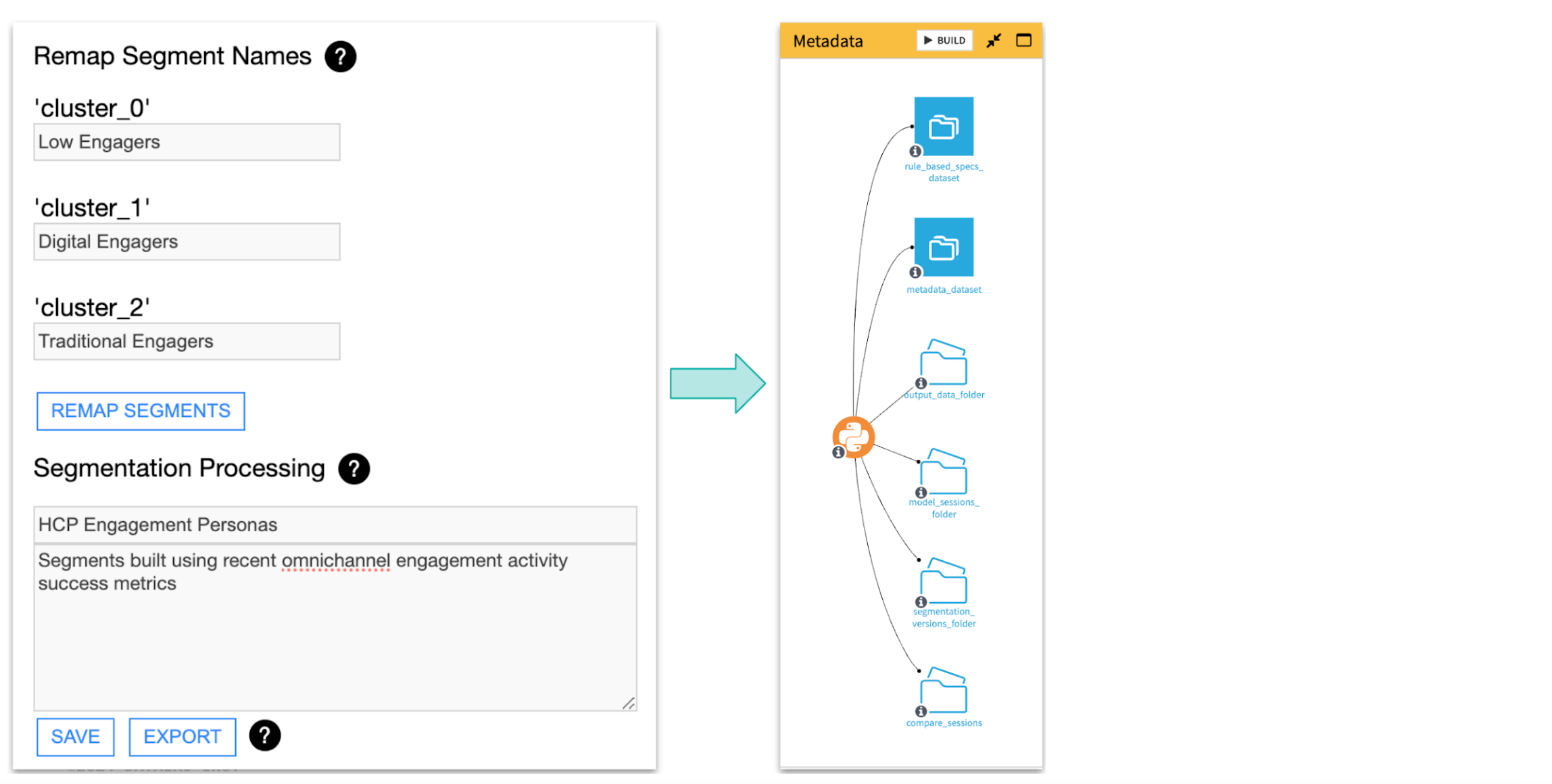Solution | Dynamic HCP Segmentation#
Overview#
Business case#
In the competitive landscape of pharmaceutical sales, more than a third of drug launches fall short of market expectations, with large global pharmaceutical organizations trailing behind small and midsize companies with only a 61% launch performance success rate.
One key reason is the challenge of inadequate market access and an insufficient understanding of market needs, coupled with difficulties in demonstrating product differentiation.
To address these issues, pharmaceutical organizations are increasingly optimizing their commercial operations. Effective engagement with healthcare professionals (HCPs) is crucial for the success of new drugs and therapies. This requires a more strategic, data-driven approach to sales and marketing efforts.
Dynamic segmentation has emerged as a powerful tool for achieving precision targeting in commercial strategies. Companies can create tailored segments that improve resource allocation and marketing impact by leveraging varied customer or HCP data, such as prescribing behaviors, patient populations, and engagement history.
Traditional sales activities are becoming less effective, and the growing complexity of prescriber behavior, limited marketing budgets, and the increasing number of communication channels necessitate a more refined approach.
Dynamic segmentation allows organizations to identify key opinion leaders, understand prescriber preferences, and better allocate sales and marketing resources, ensuring more relevant and efficient engagement strategies.
The Dynamic HCP Segmentation Solution provides a comprehensive framework for creating, managing, and comparing data-driven HCP segments that adapt to the evolving healthcare landscape. The Solution enables organizations to maintain up-to-date segments that reflect the latest market dynamics and behaviors through a combination of rule-based and machine-learning methodologies.
With features for exporting segments, exploring trends, and building rich HCP profiles, this Solution enhances omnichannel initiatives and next-best-action strategies, driving prescription volume, improving sales efficiency, and reducing waste.
Installation#
This Solution is currently in a private preview phase. If you’re interested in accessing this Solution, please reach out to your Dataiku account manager or use the general Contact Us form.
Technical requirements#
To leverage this Solution, you must meet the following requirements:
Have access to a Dataiku 13.4+* instance.
A Python 3.9 code environment named
solution_dynamic-segwith the following required packages:
dash-bootstrap-components==1.6.0
dash==2.18.1
scikit-learn==1.5.2
Data requirements#
Users should consider integrating multiple profiles, behavior, and preference data to fully realize the benefits of dynamic segmentation.
The project is initially delivered with all datasets using the filesystem connection. The Solution requires an input dataset on the Dataiku Flow, including a key column named account_id and at least one additional feature of your choice. Ideally, the data should have multiple features in the form of integers, Booleans, objects, or strings.

To fully realize the benefits of dynamic segmentation, users should consider integrating the following types of data:
Category |
Examples |
|---|---|
Prescriber profiles & demographics |
Provider’s name, specialty, location, years in practice, and practice type. |
Engagement data |
Historical sales rep visits, digital engagement, event participation. |
Prescribing behaviors |
Medication preferences, prescription volume, patient demographics, and profiles. |
Channel preferences |
Preferred communication methods and response rates across different marketing channels, from digital to face-to-face engagements. |
Market & competitor data |
Competitor analysis, information on market changes, including new drug approvals, regulatory changes, and emerging therapeutic areas. |
Key opinion leaders (KOLs) influence |
Network analysis, publications, and research activities. |
Overview#
The Solution has the following highlights:
Create data-driven HCP segments using rules-based or machine learning methodologies to improve sales allocation and marketing effectiveness.
Maintain and update fit-for-purpose segmentations across time to accommodate changing dynamics in HCP behaviors, sales initiatives, and marketing campaign outreach.
Compare and contrast different segmentations to support multi-faceted commercial efforts across your brand portfolio.
Export segments and further explore trends across or within segments and build rich HCP profile data sets to feed into omnichannel or next-best initiatives.
Extend the application of Dynamic Segmentation beyond provider-level segments through a fully flexible data model.
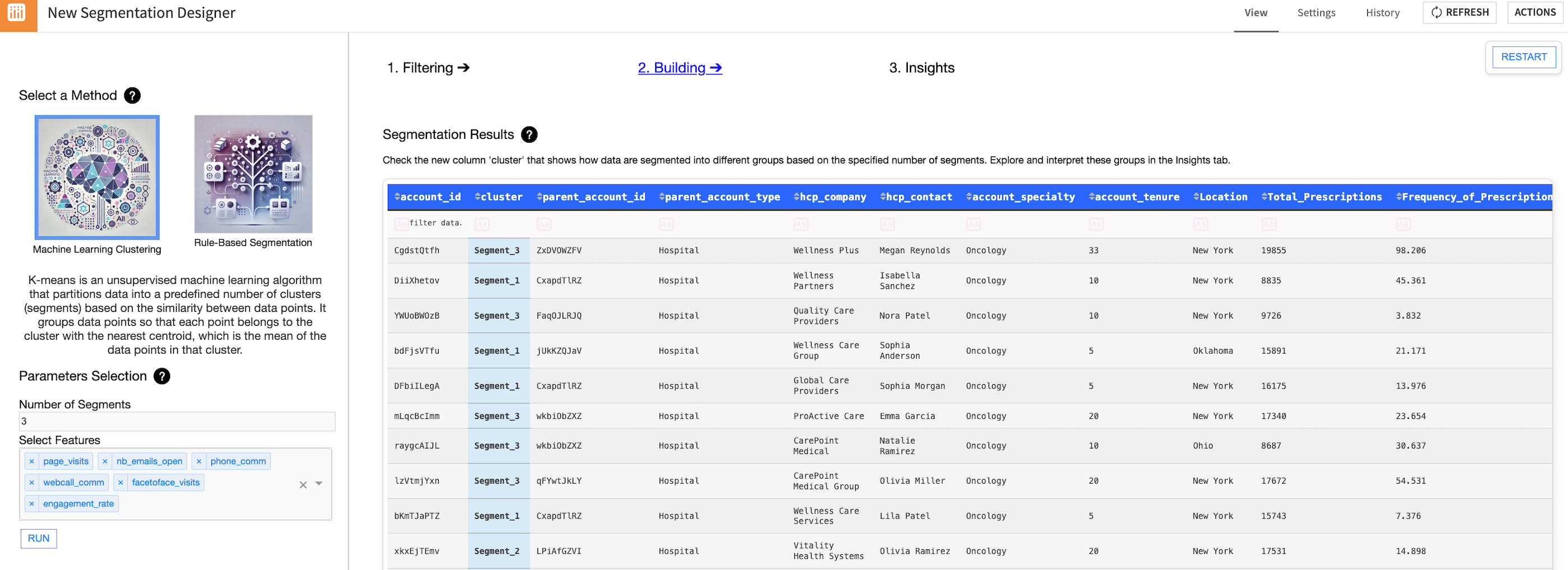
Walkthrough#
Plug and play your HCP or Patient 360 data#
The project’s default dashboard includes custom webapps. These apps constitute the heart of this Solution and deliver its most powerful functionality.
You can select customer-level data from the Dataiku Flow, apply filters, and create any number of customer segmentations aligned with your market engagement initiatives.
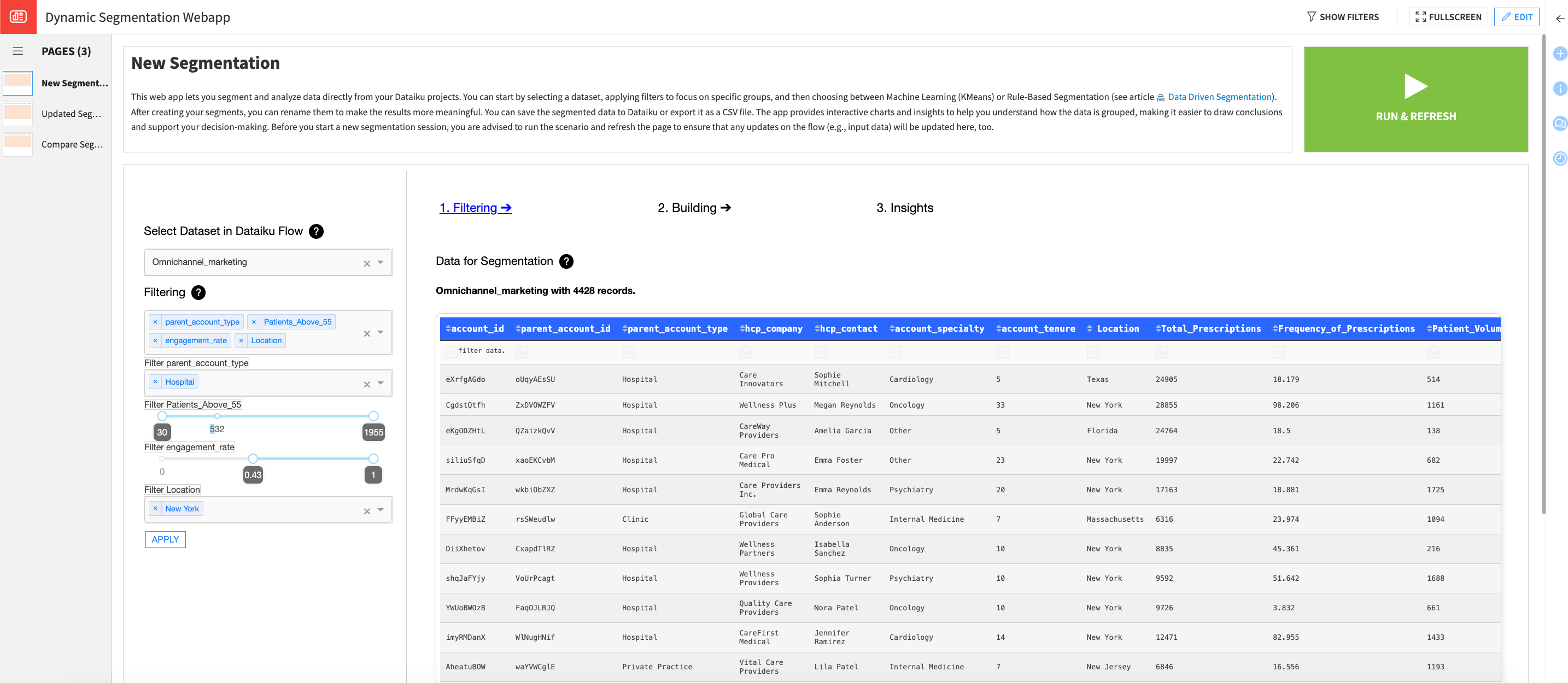
Create and explore machine learning or rule based segments#
The Solution provides two segmentation methods:
K-means clustering, which uses machine learning to group data.
Rule-based segmentation, which applies predefined rules and feature weights.
You can configure parameters, such as the number of segments, feature selection, and weights, depending on the chosen method.
After setting parameters, you can run the segmentation. The selected method will be applied, and a cluster column will be added to the original dataset.
Interactively explore the results, remap segments to intuitive names, add descriptions, and save the segmentations to managed folders in the Dataiku Flow.
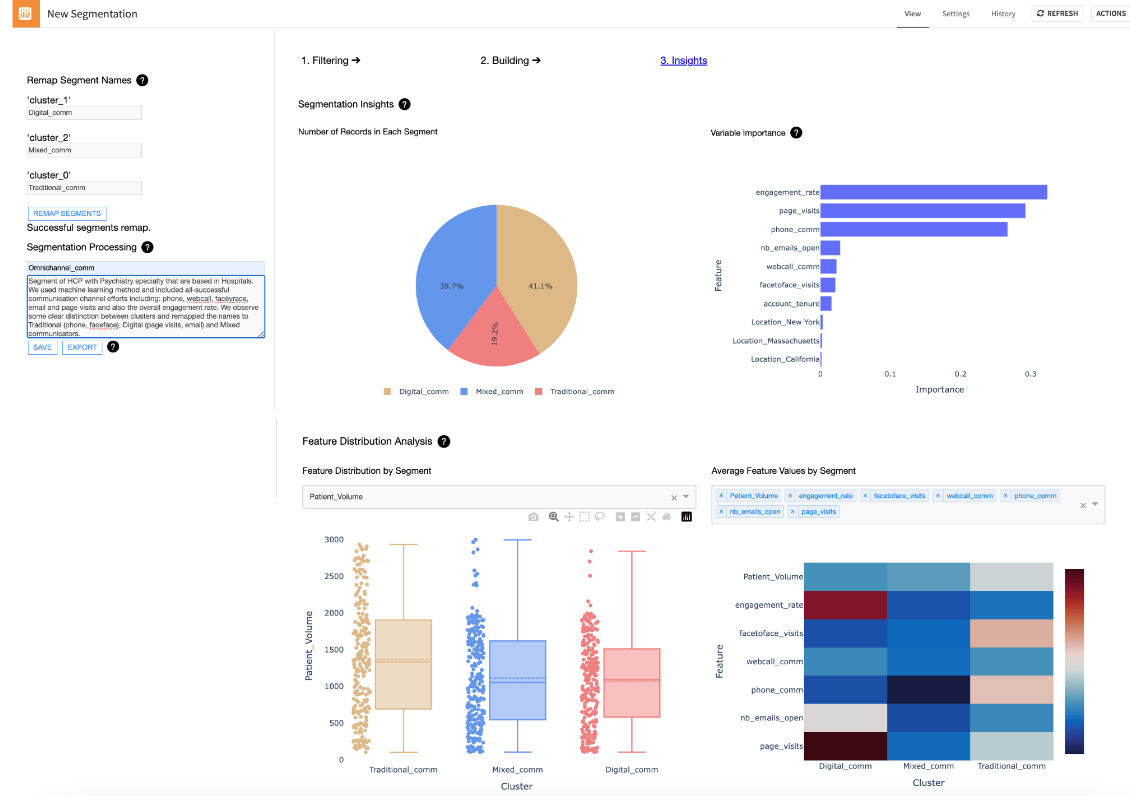
Continuously update segmentation results#
Select from saved segmentations and update them dynamically to reflect changes in new data. With an intuitive interface, users can manage segmentation sessions, review updates, and visualize customer shifts across segments using Sankey diagrams.
This interface ensures consistency by preserving the original parameters while allowing adjustments. You can export or save updated results back to the Dataiku Flow, keeping segmentation strategies dynamic and up to date.

Explore different customer segmentations#
Join and explore how different segmentation sessions align across accounts to uncover multi-dimensional insights. Search and select relevant sessions, view the combined data side-by-side, and export the results for further exploration in Dataiku.
This tool simplifies tracking changes across segmentation sessions, helping identify how segments have evolved while ensuring data consistency and accessibility through seamless integration with the Flow.
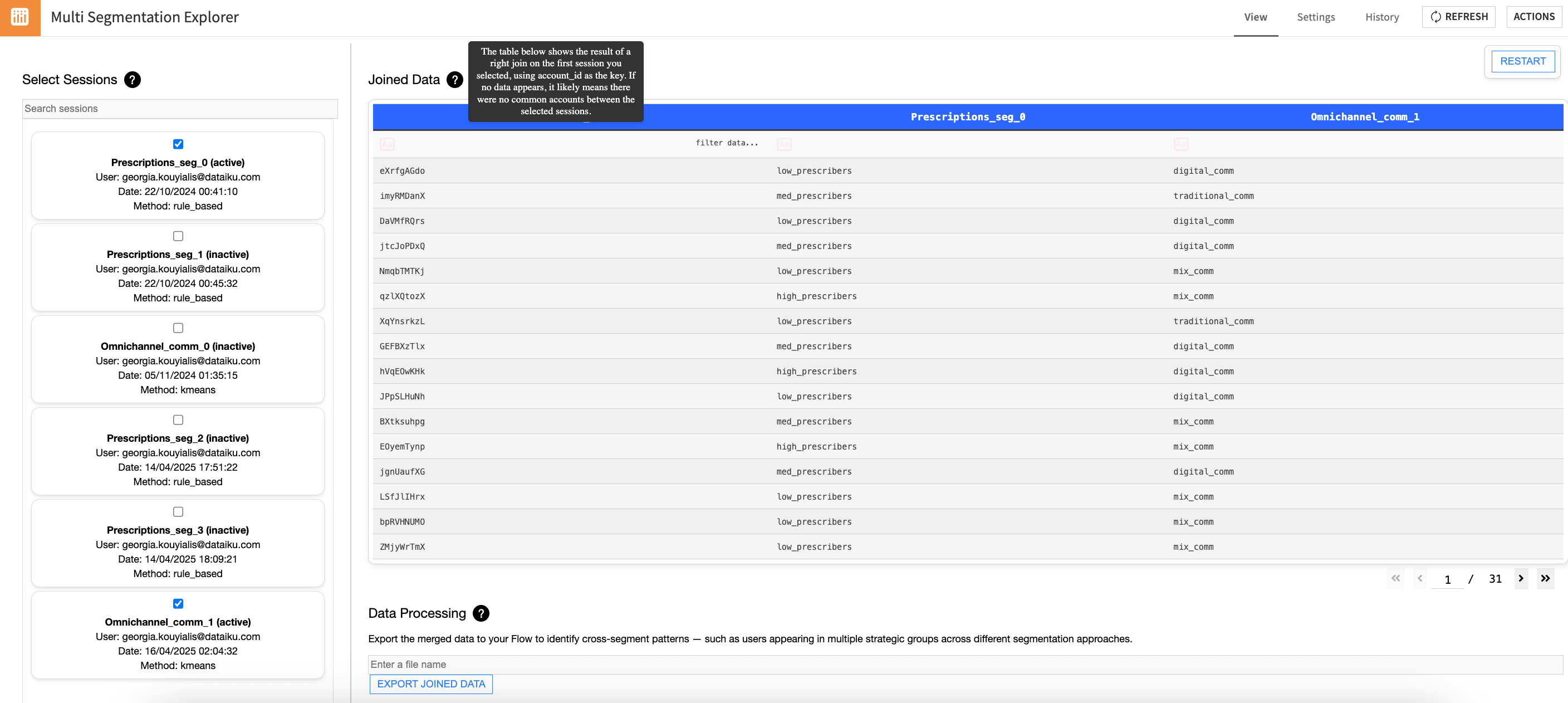
Save or export segments and comparisons#
Save and track all the segmentation sessions across time and collaborative analyst activities or simply choose to export segments for point-in-time exploration.
Explore segment comparisons with Dataiku#
Save your segment comparisons (assignment over time or across initiatives) to the Flow to build further impact analyses and rich insights with Dataiku dashboards.
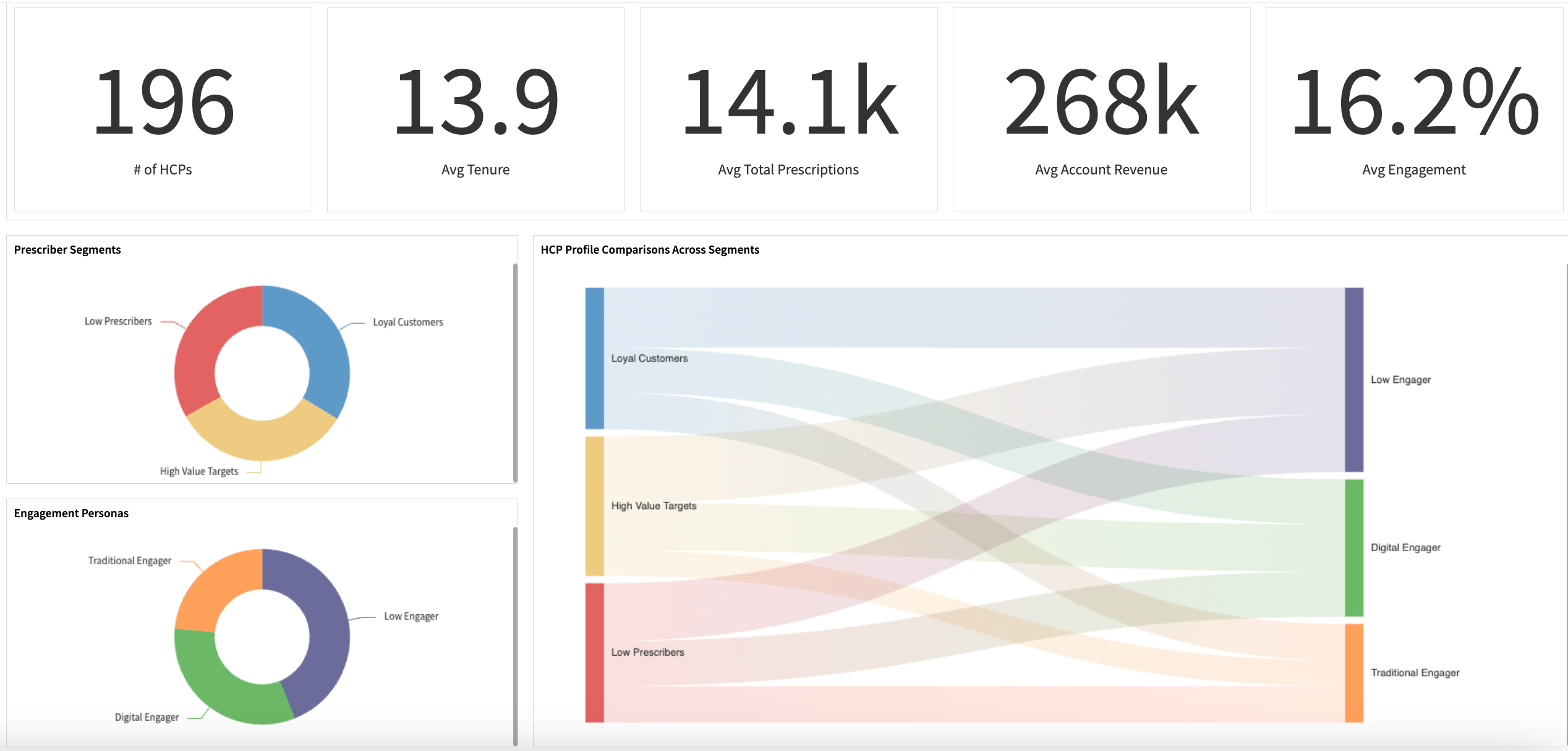
Responsible AI statement#
When developing and deploying solutions like Dynamic Segmentation in healthcare, responsible AI considerations are crucial to ensure fairness, transparency, and accountability.
Key concerns include biases in input data, such as demographic and socioeconomic biases, where over-representation of certain demographics (for example urban, tech-savvy, or wealthier regions) can lead to skewed segmentation outcomes.
To address this, datasets should represent diverse HCP profiles across regions and economic strata. You should conduct regular audits to detect imbalances.
Algorithmic bias is another concern, as models might perpetuate existing biases, thus necessitating fairness testing and adjustments during training.
Furthermore, overfitting to historical data may reinforce past patterns. Therefore, you should update models with new data on a regular basis to minimize bias and better adapt to evolving trends.
Run this Solution with minimal effort for your data#
The Dynamic Segmentation Solution provides a web application framework to create, manage, and compare various data-driven HCP segments that are dynamically updated with ongoing data collection.
This documentation has provided several suggestions on how to derive value from this Solution. Ultimately however, the “best” approach will depend on your specific needs and data. If you’re interested in adapting this project to the specific goals and needs of your organization, Dataiku offers roll-out and customization services on demand.


